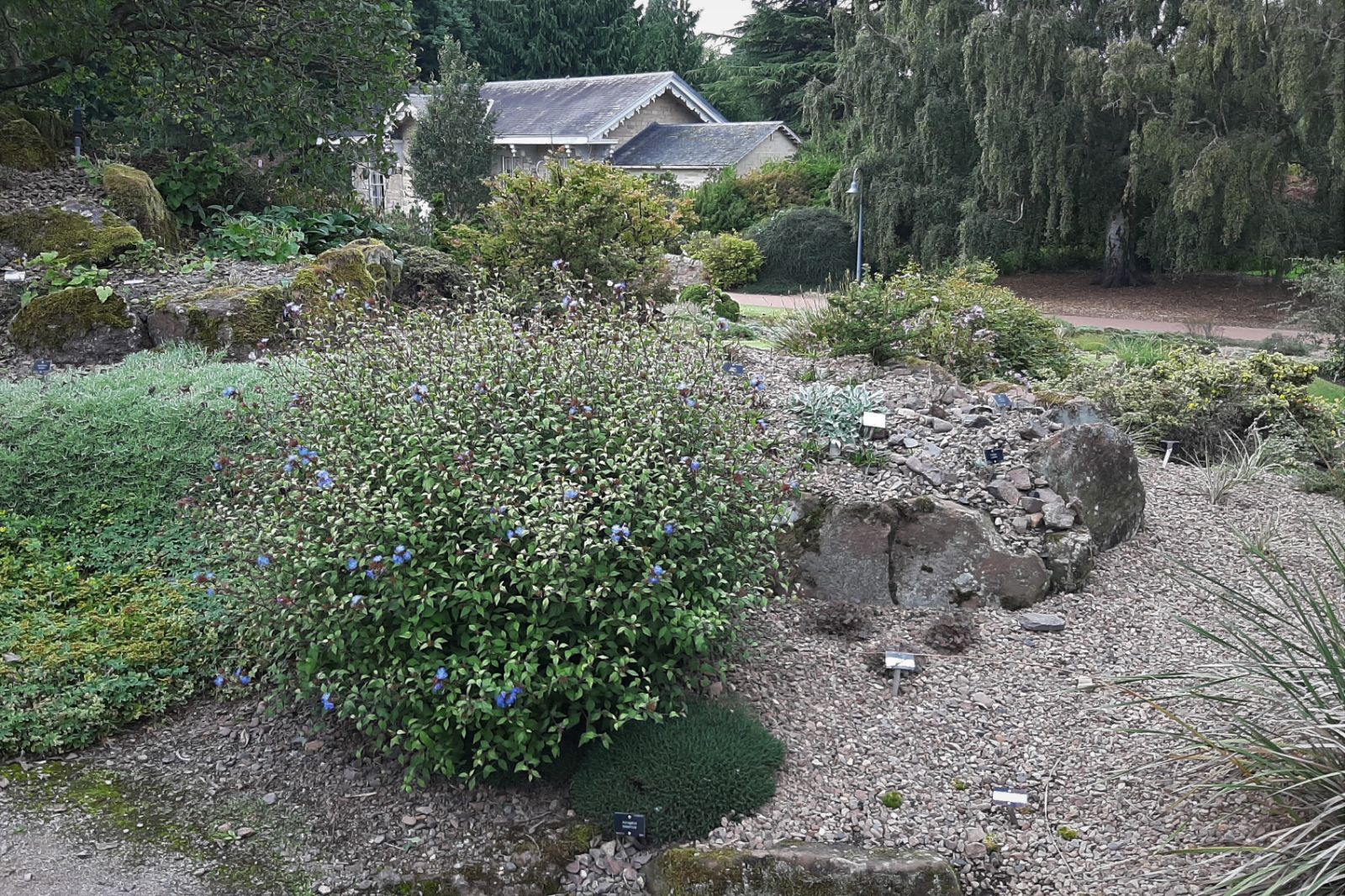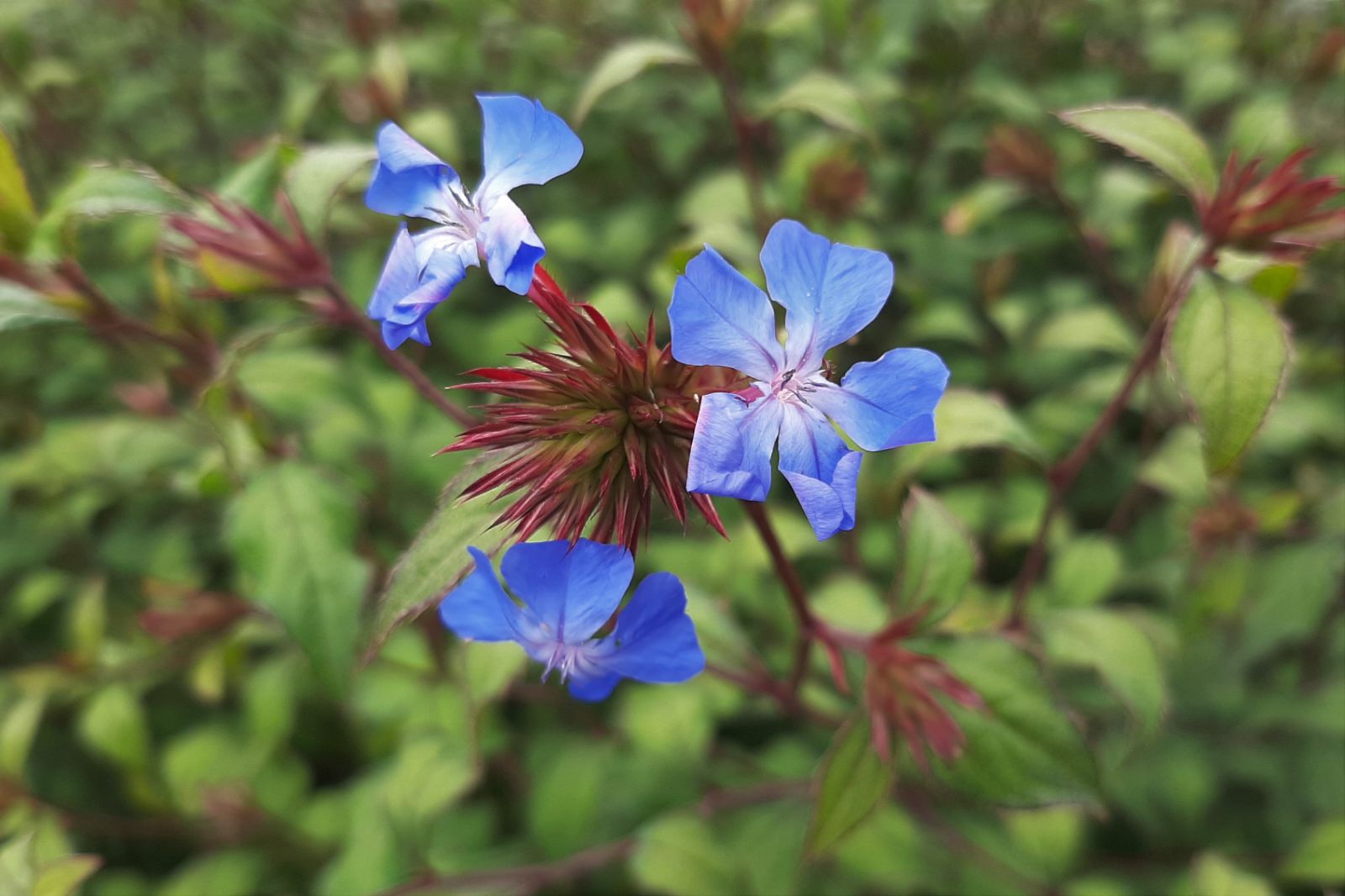Ceratostigma minus
Sponsor
Kindly sponsored by
a member of the International Dendrology Society
Credits
Julian Sutton (2021)
Recommended citation
Sutton, J. (2021), 'Ceratostigma minus' from the website Trees and Shrubs Online (treesandshrubsonline.
Genus
Synonyms
- Ceratostigma polhillii Bulley (but see taxonomic note)
Small deciduous shrub, 30–150 cm. Branches hard, pith narrower than the surrounding xylem; nodes without a ring-like scar. Branchlets with short, dense, adpressed, white or pale yellow hairs. Bud scales present. Leaf blade spathulate, obovate, or broadly diamond shaped, 2–3 × 0.8–1.6 cm, lower surface with short, dense, adpressed hairs, upper surface glabrous or only sparsely strigose; base attenuate, apex usually obtuse or rounded. Inflorescences terminal with 7–13 flowers, or axillary with 1–9 flowers; bracts oblong-ovate, 4–5 × ~2.5 mm, apex acute; bracteoles ovate, 4–5 × 1.5–2 mm, apex acuminate. Calyx 6.5–9 × ~1.5 mm, with slender adpressed hairs along the ribs. Corolla 1.5–1.9 cm, tube purple, sometimes reddish; lobes blue, obdeltate, 6–7 × 4–5 mm, apex notched and with a filiform mucro. Summer to autumn flowering, June–October in the wild. (Peng & Kamelin 1996; Cullen et al. 2011).
Distribution China S Gansu, W Sichuan, E and S Xizang, N Yunnan
Habitat Valleys, 1000–4800 m.
USDA Hardiness Zone 6-9
RHS Hardiness Rating H4
Conservation status Not evaluated (NE)
Taxonomic note Ceratostigma polhillii Bulley is a nomen nudum, published with a scant description and origin only “high altitude… Western China” (Bulley 1901), compatible with C. minus. Prain (1906) listed a plant “in loco vix certo, Bulleyi mercen.!” (so presumably offered by Bees Nursery) among specimens of C. minus, without mentioning the name C. polhillii (note that this was before C. willmottianum had been recognized). Ernest Wilson (in Sargent 1916) and the horticultural literature (Bean 1976; Cullen et al. 2011; Edwards & Marshall 2019) have taken C. polhillii to be synonymous with C. minus.
Plants under this name have appeared in gardens from time to time, but no one introduction seems ever to have been common, and identifications are uncertain.
C. minus belongs to a group of rather similar western Chinese species, with C. willmottianum and C. griffithii, rather intermediate between them in range and appearance. The original description (Prain 1906) was based on several specimens from Sichuan, Yunnan and Xizang which had in common a more or less glabrous upper leaf surface, unlike the other two species. This is as close to a defining feature as we can get, although (Peng & Kamelin 1996) also place some forms with a hairy upper surface here, although these have whitish or yellow hairs on the young shoots, rather than the red-brown hairs of C. willmottianum. Horticultural descriptions in particular claim it as a smaller plant overall than C. griffithii (e.g. Edwards & Marshall 2019) Images of it growing on the Tibetan Plateau near Lhasa, Xizang certainly show a beautifully compact shrublet whose deep blue flowers contrast strikingly with red bracts (Holubec 2020), but it is likely to behave quite differently in low altitude gardens. Frank Kingdon Ward noted its crimson calyx (Bean 1976). It is plausible that C. minus may intergrade with one or both of these species.
Plants which probably belong here seem to have been distributed in the very early 20th century by Arthur Bulley (Bean 1976), probably through his Bees Nursery, under the invalid name C. polhillii (see Taxonomic Note above). Bulley had received it from the English missionary Cecil Polhill (his name was changed from Polhill-Turner by deed poll to ‘suit the times’ – Usher 2021), stationed in Kangding, Sichuan. Later collections attributed to C. minus include SICH 391, collected just a few kilometres south of Kangding (Quarryhill Botanical Garden 2021). SICH 59 from the Min River gorge, Sichuan is sometimes placed here, but sometimes identified as C. willmottianum (Quarryhill Botanical Garden 2021; Royal Botanic Garden Edinburgh 2021), highlighting identification difficulties in this group. A plant from this last collection on the Edinburgh rock garden, where it is labelled as C. minus, looks lower and more dense than the typical British experience of C. willmottianum, and is ‘a very nice, compact-looking shrub’ (J. Grimshaw pers. comm. 2021).
C. minus is claimed as heterostylous by Costa et al. (2019), subject again to correct identification.


